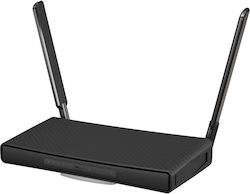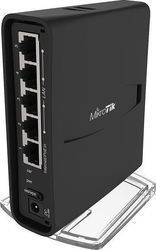






MikroTik Access Point Wi‑Fi 5 Dual Band (2.4 & 5GHz)
Wi‑Fi 5, WLAN:1167Mbps, LAN:1000Mbps
from99,00 € at 17 storesMikroTik Access Point Wi‑Fi 4 Single Band (2.4GHz)
Wi‑Fi 4, WLAN:300Mbps, LAN:100Mbps
from42,76 € at 18 storesMikroTik LtAP-2HnD&FG621-EA&LR8, LtAP LR8 LTE6 kit
Wi‑Fi 4, WLAN:300Mbps, LAN:1000Mbps
from313,69 € at 3 storesMikroTik Audience LTE6 kit WiFi Mesh Network
Wi‑Fi 5, WLAN:1733Mbps, LAN:1000Mbps
from256,99 € at 2 stores
Filters
Clear- Wi‑Fi 4: Older Wi-Fi standard, significantly slower than Wi-Fi 5 and Wi-Fi 6. Recommended for use with few devices and for applications that do not require high speeds.
- Wi‑Fi 5: The most widely used Wi-Fi standard, significantly faster than Wi-Fi 4. It meets the needs of most users at present.
- Wi‑Fi 6: It offers faster speed, the ability to connect more devices, and less battery consumption on their part.
- Wi‑Fi 6E: The latest standard. It offers more available channels to reduce interference in wireless networks, while also providing better speeds and lower latency compared to WiFi 6.
- WIFI Mesh: Technology that allows the creation of a unified, flexible network where multiple Access Points work together to provide broader and more stable Wi-Fi coverage. Ideal for large homes, offices, and businesses.
- Indoors: Simple installation, indoors.
- Outdoors: Flexible mounting options to adapt to various outdoor surfaces and weather-resistant.
- Single Band (2.4GHz): For wider coverage compared to that of the 5GHz. However, it has lower speed compared to that of the 5GHz.
- Single Band (5GHz): For coverage of a smaller area compared to that covered by 2.4Ghz, but with higher speeds.
- Dual Band (2.4 & 5GHz): Choose between greater range and lower speed or lower range and higher speed.
- Tri Band (2.4 & 5 & 5GHz): It offers a wider bandwidth compared to other frequencies, avoiding interference. An ideal choice for large spaces with multiple devices that require high-speed data transmission.
- Ethernet: Wired connection capability through an Ethernet network port. Allows connection via Ethernet cable, ensuring stable and reliable connection, high data transfer speeds, and reduced interference compared to Wi-Fi.
- USB: Allows the connection of external devices, such as USB flash drives, external hard drives, or printers. It is mainly used for file sharing and media streaming within the network, offering flexibility and additional functions in the wireless environment.
- Shipped from Skroutz Hub: Products available for shipping directly via our warehouse, Skroutz Hub.
- Offers: Products with a significant price drop.